Two Latent Mysteries of Triple Pulse Study
Liminals & the Subconscious? What are Liminals? And what does this mysterious and unfamiliar term have to do with the equally mysterious Subconscious? First a little background.
Mathematical Mystery: Why Interruptions to the Rest Pulse affect the Active Pulse
In the process of our prior investigations, we became aware of two latent mysteries - one mathematical and the other neurological. We uncovered one of these mysteries in our investigation of the Triple Pulse Results. We saw that interruptions to the Rest Pulse have a negative impact upon the potentials of the ensuing Active Pulse. We proposed that this innate mathematical feature of the Triple Pulse corresponds with the Sleep Deprivation Phenomenon. We have not yet discussed the mathematics behind this phenomenon. What is it about the inner workings of the Triple Pulse that allows one part of the process to have an effect upon another part? This is the mathematical mystery we will explore.
Neurological Mystery: Why is the brain incredibly activity during sleep?
In the prior article on Sleep Necessity, we saw that although the body may crave slumber, sleep has nothing to do with resting the brain. Indeed, the neurology of the brain is incredibly active during sleep. Our study suggests that the mathematics of the Triple Pulse simulates the Sleep Necessity phenomenon. We have not yet discussed the nature of the intense brain activity that occurs during sleep. Why does the brain continue to be neurologically active when the body is sleeping? This is the neurological mystery we will explore. Is there any correspondence between the Triple Pulse and the intense mental activity of slumber?
To propose an answer to these questions we must introduce another feature of the Living Algorithm’s digestion process – the Liminals.
Zeroing out the Triple Pulse
In our article on Triple Pulse Results, we saw that interruptions to the Rest Pulse have a negative impact on the potentials of the following Active Pulse. Why is this so? What mathematical mechanism is behind this intriguing result?
3 Inherent Features of the Living Algorithm
To answer this question let us first review three of the Triple Pulse's inherent mathematical features.
1) In the ideal Triple Pulse, each of the three pulses begin at zero and ends by zeroing out on the horizontal x-axis (see Graph A below).
2) This characteristic zeroing out of the ideal pulse is consistently absent whenever interruptions occur during the pulse (see Graph B below).
3) The verbal and visual analysis in the article regarding the Triple Pulse Results clearly demonstrates that interruptions to the Rest Pulse bleed the ideal potentials from the ensuing Active Pulse. Note in Graph B how the peak of Active Pulse #2 is noticeably reduced in comparison to Active Pulse #1.
A: Ideal Triple Pulse
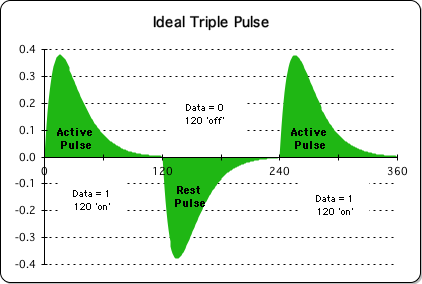
B. Interrupted Rest Pulse
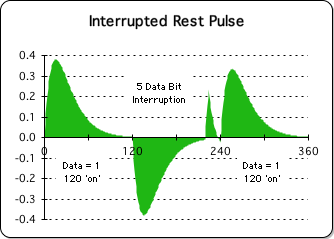
The mathematics of the Living Algorithm dictates each of these 3 innate features. The question arises: Is there any connection between the failure of the Rest Pulse to zero out and the ensuing Active Pulse's failure to achieve his potentials? To answer this question we must introduce the Liminals, another feature of the Living Algorithm's digestion process.
Triple Pulse: a graphic visualization of the 2nd derivative of a specific data stream.
Remember: the Living Algorithm’s sole function is digesting data streams. Her algorithm (procedure) produces the ongoing rates of change (the derivatives) of any data stream, whether living or dead. These ongoing derivatives characterize the individual moments in the data stream by relating the current moment to prior rates of change. There are an infinity of these data stream derivatives, some more useful than others. Thus far, we have only examined the behavior of one of the Living Algorithm’s derivatives. The Triple Pulse, the prime focus of our attention, is the graphic visualization of the 2nd derivative of a data stream consisting of the aforementioned sequence of 1’s and 0s. We refer to the 2nd derivative as the Directional.
Liminals: the data stream's higher derivatives
C. The Liminals of the Triple Pulse Data Stream
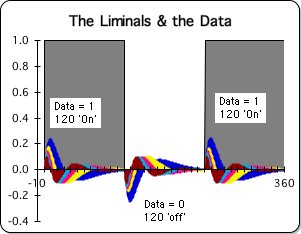
D. Ideal Triple Pulse - All pulses zero out
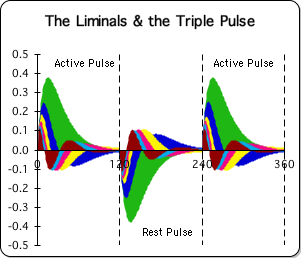
E. Interrupted Rest Pulse: Resulting Turbulence
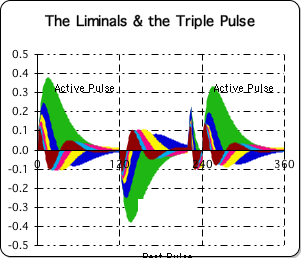
F. Close-up of Interrupted Rest Pulse
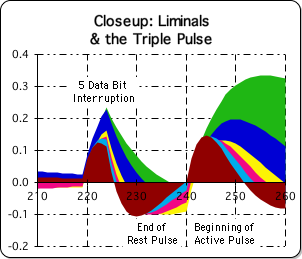
G. Close-up of an Uninterrupted Rest Pulse
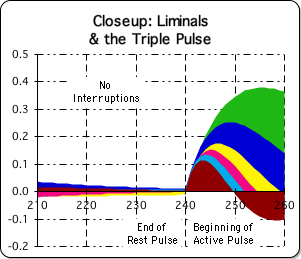
H. Close-up of Interrupted Triple Pulse only
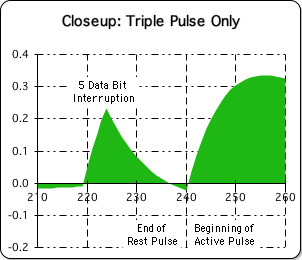
The other Living Algorithm derivatives also reveal significant features of a data stream. Although we have only examined the data stream’s 2nd derivative up to this point in our investigation, the higher derivatives also have something unique to say about moments in a data stream. We refer to these higher derivatives as a group. We call them Liminals. The Living Algorithm’s Liminals are the subject of this article. At right (Graph C) is a particular visualization of the Liminals (the multicolored swatches). This is the result when the Living Algorithm digests the same data stream that generates the Triple Pulse. We have included the data of 1s and 0s in the background for comparison.
Liminals zero out at end of each Pulse
Now lets view the Triple Pulse (the data stream’s 2nd derivative) together with the Liminals (the higher derivatives). See Graph D. Notice how all the derivatives (Triple Pulse and Liminals) zero out together. This simultaneous zeroing out of the derivatives occurs in both phases of the Triple Pulse, i.e. the Active and Rest Pulses. Even though each of the data stream derivatives zeros out simultaneously, the Liminals revolve above and below the horizontal line (the x-axis). This alternation occurs during both the Active Pulse and the Rest Pulse.
Interrupted Liminals prevent Rest Pulse from zeroing out
Now let us look at what happens to the Liminals when the Rest Pulse is interrupted at the end of 'her' cycle (Graph E). Notice how disturbed the Liminals are. Instead of settling down, as they normally do, they are bouncing around the x-axis like ants that have been disrupted. The Liminals swell to many times their normal size indicating the level of this disturbance. It is evident that interruptions create turbulence for the Liminals, which prevents the Rest Pulse from zeroing out in 'her' allotted 'time'. Graph F is a close-up of this mathematical phenomenon. (The graph focuses upon the interruption at the end of the Rest Pulse along with the ensuing turbulence). Notice in particular how aroused the reddish brown swatch is. This swatch is a visualization of the data stream’s 6th derivative. Normally the 6th derivative is much smaller than the other derivatives. Now this higher derivative dominates the landscape.
Liminals' Turbulence disrupts Rhythm of Ensuing Pulse
These interruptions also have another interesting effect. The turbulence of the interrupted Liminals prevents the ensuing Active Pulse from realizing 'his potentials' (maximum dimensions). Why? The disturbance of the Liminals bleeds into the beginning of following pulse. The turbulence interferes with and disrupts the rhythm of the pulse. To maximize potentials, both the Active Pulse and the Liminals must start at 0. This insures that all data stream derivatives move in the same direction once the string of 1s that generates the Active Pulse is initiated. If even one of the Liminals is moving in a contrary direction, this inhibits the Active Pulse from accumulating forward momentum. In general, we can say that interruptions in any given pulse prevent the derivatives of that pulse from zeroing out. And the failure of the pulse to zero out disrupts the rhythm of the following pulse.
Graphic Visualizations
Graph E is a sample visualization of how the turbulence of the Liminals bleeds into the next Active Pulse. This is an abstract mathematical reality, generated solely by numbers and an equation. Graph F is a close-up of the transition between the interrupted Rest Pulse and the following Active Pulse. Graph G is a close-up of the transition between an uninterrupted Rest Pulse and the following Active Pulse. Note how calm and orderly it looks in comparison to the preceding graph of the interrupted Pulse. To see how important the Liminals are in this process, check out how benign the interrupted Triple Pulse (the 2nd derivative) is all by itself - shown in Graph H.
Family, Team, Liminals must work together to maximize performance
This process can be likened to the disrupting negative effect on a team's performance of interpersonal turbulence between individual players. This 'interruption' means that all players on the team are not focused in the same direction when the game begins. This distraction inevitably impacts performance. The team metaphor is particularly apropos to the Living Algorithm's derivatives. The data stream derivatives either work together towards a common goal and generate a lofty peak (of insight or inspiration?), or the derivatives work at cross-purposes and are unable to generate anything other than puny molehills (as exhibited by the Random Graph). This entire analysis exhibits how interrelated the data stream derivatives are. Each derivative plays an integral role in determining the potentials of the Pulse. When all derivatives move together, 'great accomplishments are achieved'. When they don't, the results are mediocre, at best.
Conclusions
This analysis resolves the mathematical mystery. Interruptions to the Rest Pulse significantly reduce the dimensions (both the peak and area) of the ensuing Active Pulse. Why? In the ideal Triple Pulse, all the derivatives begin and end at zero. Interruptions in any given pulse prevent that pulse from zeroing out and therefore disrupt the rhythm of the following pulse. Now let us tackle the neurological mystery.
21st Century Science: Brain 'unbelievably active' during sleep
The Neurological Mystery
Let us read what the eloquent Dr. John Medina says about the brain during sleep.
“If you ever get a chance to listen in on a living brain while it is slumbering … the brain does not appear to be asleep at all. Rather, it is almost unbelievably active during “rest”, with legions of neurons crackling electrical commands to one another in constantly shifting patterns – displaying greater rhythmical activity during sleep, actually, than when it is wide awake. … Researchers early on began to disabuse themselves of the notion that the reason we rest is so that we can rest, when the brain is asleep, the brain is not resting at all. “ (Medina, brain rules, pp. 152&3)
The neurological mystery? Why is the brain so active during sleep? Does the mathematics of the Triple Pulse sync up with this unusual phenomenon?
Triple Pulse components: Green Active & Rest Pulses and Multi-colored Liminals
Before exploring this question let's revisit the mathematical facts. Up to this point we have identified multiple components of the Triple Pulse. The Living Algorithm digests a specific data stream. This procedure generates the ideal Triple Pulse, which consists of an Active Pulse (above the line) and a Rest Pulse (below the line). It also generates the Liminals. The green area defines the boundaries of the three pulses, while the multi-colored Liminals dance around the centerline (the x-axis). All curves approach the centerline at the end of each of the three pulses. This provides further definition to each pulse.
Agenda of Liminals independent of Pulse
Although both the Pulses and the Liminals approach zero together in the ideal circumstance, the agenda of each of the Liminals is independent of the entire pulse. On observation it is clearly evident that each of the Liminals consists of a variety of mini-pulses that have two features. First, these mini-pulses rise above and descend below the centerline in a regular pattern. And second, they gradually decrease in magnitude over the span of the pulse. This is entirely different from the defining green curve, which is either above or below the centerline (the x-axis) during the entire pulse.
Liminals: Subconscious Cognition?
In the prior Sleep Deprivation article we examined experimental evidence that suggested that the Active Pulse corresponds with the consciousness of the waking state and the Rest Pulse with the unconsciousness of the sleep state. Liminals are very active during both phases of the Triple Pulse – Active and Rest. If the Active and Rest Pulses (green) represent the alternation of consciousness and unconsciousness, what do the multi-colored Liminals represent? Could Liminals be associated with subconscious mental activity?
Definitions: Conscious, Unconscious, & Subconscious
Definition corresponds with Experience
We've been throwing around some powerful words. Let us propose some working definitions, so that we don't get lost in common misunderstanding. We will formulate some limited definitions based on the results of our studies. This usage may be slightly different than the meaning we are accustomed to. We suggest that when we are conscious we are continuously taking in information. Alternately when we are unconscious our information absorption system is turned off. Subconscious activity is the state of digesting and organizing information. Subconscious activity is present in both the conscious and unconscious states. These definitions correspond with our experience. When we are awake (conscious), we take in info; and when we are asleep (unconscious), we don't. Waking or sleeping, subconscious mental processes seem to actively process and digest information.
Mathematical Correspondence
Let’s see how these definitions play out mathematically. Let’s think of the Triple Pulse as a system that turns on and off. The Active Pulse of 1s, as Consciousness, receives information when the System is on. The Rest Pulse of 0s, as Unconsciousness, receives no information when the System is off. Further the Liminals, as the Subconscious, are digesting information whether the System is on or off.
Liminals: Reason for Name
Just as the subconscious is continuously active during waking and sleeping, during both pulses the Liminals revolve about the x-axis (the centerline). They are alternately subliminal and super-liminal. Because they revolve about the threshold of the conscious and unconscious state (the liminal line) we choose to call them Liminals.
Do these correspondences hold water when placed face to face with experimental reality?
Experimental Correspondence
The neurological evidence is conclusive; the brain is incredibly active whether we are awake or asleep. Our results have illustrated that the Active Pulse is related to being awake (Conscious) and that the Rest Pulse is associated with being asleep (Unconscious). It makes logical sense that the consistently active Liminals (the Subconscious) should be associated with the continuous neurological activity of the brain. The Living Algorithm's Liminals simulate the intense neurological activity of the brain when we are sleeping.
Theory: Subconscious continues to process Info while we sleep
When scientists began studying sleep, they suspected that both the body and brain shut down at this time, presumably to rest. Their findings contradicted this notion. Surprisingly, the brain continued to be active during sleep. Based upon our proposed correspondences between the Triple Pulse components and cognitive reality, our theory is that the subconscious continues to process or digest information after the conscious shuts down.
The Liminals & the Subconscious: some casual Associations
Suggestive Associations lend credence to Theory
Connecting the wobbly lines of the Liminals with the Subconscious is a big jump - suggestive at best. For this association to have any validity whatsoever there must be other connections to bolster the analysis. Are there any other connections between the Liminals and the Subconscious? We believe there are. However, these patterns of correspondence are merely suggestive. Our theory that the Liminals are associated with the Subconscious will, of course, require more substantiation. These associations will not invalidate the theory, but will lend additional credence to it.
Liminals: Dreaming?
The first association is fun – just some innocent speculation. At the turn of the last century, Sigmund Freud suggested that the subconscious is associated with dreaming. According to his theory, during sleep the subconscious digests emotionally charged information that was taken in during the day. This process frequently manifests as dreams. Freud interpreted dreams through the process of word association. Although Freud's theories are not uniformly accepted in the current scientific community, they have entered popular consciousness. Many, if not most, feel that dreaming is the realm of the subconscious. We remember these surreal stories of the subconscious as we pass the threshold of consciousness upon waking. Sometimes these fragmented scenarios even wake us from sleep when the mental activity becomes too intense. This is very similar to the activity of the Liminals during the Rest Pulse. (See the graph above right.) Notice how active the Liminals are during the Rest Pulse (Sleep), even popping over the centerline (x-axis) during the middle of the cycle. Could this be somehow related to dreaming? We don't know, but it certainly qualifies as a fun association between the Liminals and dreaming. It certainly does not contradict their growing relationship.
Infinite Subconscious versus a Point of Consciousness
One notable difference between the conscious and the subconscious is that the conscious is but a point to the relative infinity of the subconscious. In his book, The Biology of Belief (2008), noted biologist Dr. Bruce H. Lipton illustrates this point graphically. He first shows us a picture of Machu Pichu, which contains 20,000,000 pixel dots. Our subconscious mind processes this information, the entire picture, in one second. How much does the conscious mind absorb? One pixel. This relationship is shown in the picture below (taken from Dr. Lipton's book p. 137). He further states that he had to blow up the conscious dot by 10X to make it visible.
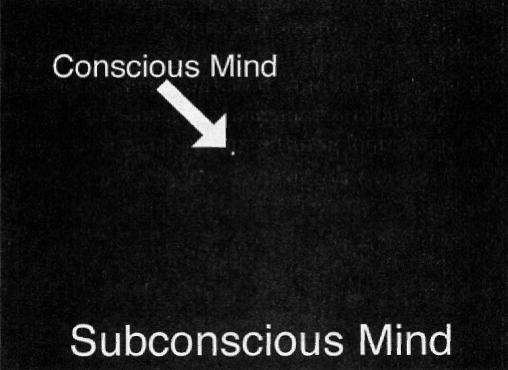
Infinite number of Liminals and their relationships: Just one Triple Pulse
Similarly, it takes only one of the Living Algorithm's derivatives (the 2nd) to generate the Triple Pulse. However, the Liminals consist of an infinite number of derivatives. We have only chosen to show 5 of them in our graphs. Further, this infinity of Liminals forms an infinite number of relationships between themselves. Just as the information processing capabilities of the Subconscious dwarfs the Conscious, the number of the Liminals and their interactions dwarfs the other Living Algorithm derivatives.
Tentative Explanation of Neurological Mystery
This analysis states that the Liminals mimic the intense brain activity during sleep. But it does not answer the real mystery that baffles cognitive scientists: What causes the brain activity during sleep? The preceding analysis only establishes a relationship between the Triple Pulse and this experimentally verified phenomenon, but does not propose an answer to the question.
Living Algorithm Info Patterns suggests Answer
Now that we have established some plausible associations between the Living Algorithm Information Patterns and the different states of consciousness, we can propose a preliminary answer to the question of why the brain is incredibly active during sleep. This answer is based upon our Sleep & Learning Theory, whose foundation lays in Living Algorithm Mathematics, or more appropriately her Information Patterns.
Mathematics: Rest Pulse required to digest Energy Accumulation from Active Pulse
The theory begins with a fundamental mathematical principle of the Living Algorithm System. Once info energy (data) enters the System it must be consumed completely. (The complex information in this paragraph is dealt with in future articles.) During the Active Pulse of 1s this info energy is only partially consumed. This leads to an accumulation of undigested info energy. Further, as the end of the Active Pulse is approached, the System becomes less efficient and less is accomplished over a greater period of time. To maximize productivity the System turns off at this point. This initiates the Rest Pulse of 0s. During the Rest Pulse, when the System is 'off', the System has 'time' to consume the excess info energy that accumulated during the Active Pulse. Once the System has consumed this residual info energy, it turns back on again - initiating a new Active Pulse. As the cycle begins anew more info energy enters the System, As before, this energy is only partially consumed. A Rest Pulse is required to digest this accumulating data energy. And so on and so forth. This is a purely mathematical process.
Subconscious requires Sleep to completely digest Energy Accumulation of the Day
Now let us see what happens when we link the mathematics with our associations. We wake up and begin taking in information (the Active Pulse's Conscious State). Our Subconscious (the Liminals) are only able to digest part of this information. The rest of the info energy remains undigested. Once our System shuts off and we go to sleep (the Rest Pulse's Unconscious State) our Subconscious (the Liminals) has time to finish the work of assimilating and organizing the info energy that was absorbed during the day. After the wine cases are delivered, the staff must have sufficient time to put them on the shelves.
Intense brain activity during sleep: Subconscious (Liminals) working overtime to process info
With this analysis in mind, it is somewhat obvious why the brain shows so much neurological activity during sleep. The Subconscious is working furiously to digest all the leftover Information that was absorbed during the day. Because of the constant intake of information during the waking state, the Subconscious is unable to completely digest and organize the information. The down time of Sleep is required to give our subconscious mental processes the necessary time to finish the task. The intense mental activity during the sleep state is the Subconscious working overtime to put everything in its proper place.
Theory requires many support articles, but opportunity to meet Liminals
To establish the foundations of this analysis we must first examine the Living Algorithm System and Data Stream Dynamics, each of which is covered in its own notebook. We introduced this analysis at this point in our presentation for two reasons. First, in our discussion of the necessity of sleep we discovered that the brain was incredibly active during this period. Second, this provided us with an opportunity to meet the Liminals.
Connecting the Dots
Triple Pulse’s mathematics parallels 4 diverse phenomena
Prior articles established that there is a distinct pattern of correspondence between the mathematics of the Living Algorithm and 4 scientifically verified behavioral phenomena: the Interruption Phenomenon, Sleep Deprivation, Sleep Necessity, and the Importance of Naps. Although these phenomena mystify theorists, the scientific community (as represented by Dr. Medina’s brain rules) embraces their reality due to copious experimental validation. Although experiments can never absolutely prove a causal correlation, they can disprove correspondences. Interestingly enough, none of the experimental findings have contradicted the underlying mathematics of the Triple Pulse. This holds true despite the diversity of phenomena that we have examined. In fact, the closer we look, the deeper the correspondence seems. For instance, we were surprised to find that the mathematical behavior of the Liminals during the Rest Pulse parallels the intense activity of the brain during sleep. In fact, evidence suggests that the Liminals correspond with subconscious brain activity. The growing chain of correspondences lends credence to the notion that Triple Pulse mathematics provides a model for significant features of human behavior.
Four different mathematical features parallel 4 diverse phenomena
Four unexplained phenomena find a home under one mathematical umbrella. In addition, the ribs of the umbrella are comprised of four mathematical features of the Triple Pulse model, which we employ as explanatory tools;
- 1) ‘Interruptions’ to the Active Pulse (the interruption Phenomenon).
- 2) ‘Interruptions’ to the Rest Pulse (Sleep Deprivation).
- 3) The mathematical fact that the Active Pulse fades out permanently unless refreshed by the Rest Pulse (Sleep Necessity and Naps).
- 4) The mathematical fact that the Liminals are active during the Rest Pulse (brain activity during sleep).
These four diverse mathematical features of the Triple Pulse simulate four unexplained phenomena that have been experimentally verified.
4X5 correspondence web grows stronger
The web is growing stronger with each new strand that links the Triple Pulse with human behavior. Is it still possible to claim that a coincidence links such diverse features into one package? Or is it possible that something else binds the Triple Pulse’s mathematics with human behavior? Could that 'something else' be the way humans digest information?
Is this correspondence yet another coincidence linked by a confounding variable?
Is this correspondence between human behavior and the Living Algorithm System yet another in a long chain of coincidences? Is there a confounding variable that somehow links these innate mathematical processes with our ability to digest information? Or could the linkage be associated with the mathematics of information digestion? Could the Living Algorithm actually be a method by which living systems digest the constant flow of environmental information? On a more immediate level, is there any more evidence linking the Living Algorithm System with any other features of sleep?
A Mathematical bridge between Psychology and Biology?
Rather than attempt a definitive answer, let us explore yet another pattern of correspondence – this time between the Triple Pulse and Biological Sleep. We have now shifted our investigation from psychological phenomena to a biological phenomenon. Will the Triple Pulse model be invalidated? Will she finally meet her match in this fateful encounter? Or will the Triple Pulse be able to provide a mathematical bridge linking biology and psychology?
For some preliminary answers to these questions, check out the next article in the series - The Triple Pulse & the Biology of Sleep.
Links
For the Author’s personal process of discovery, read Wife Collaborator links Subconscious with the Liminals.
For Life’s reaction to this interaction, return to our alternate universe – Life overwhelmed by Liminals/Subconscious correspondence.
